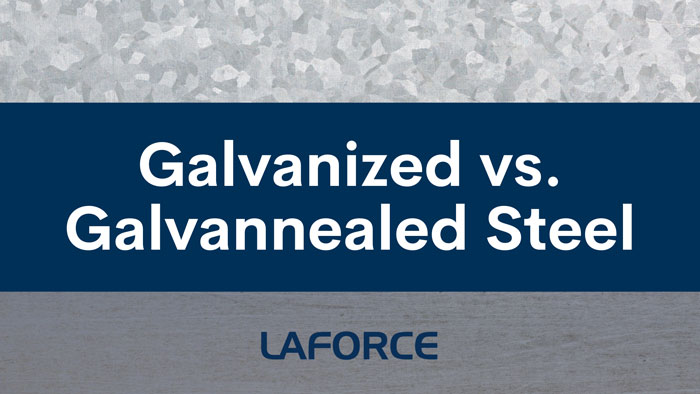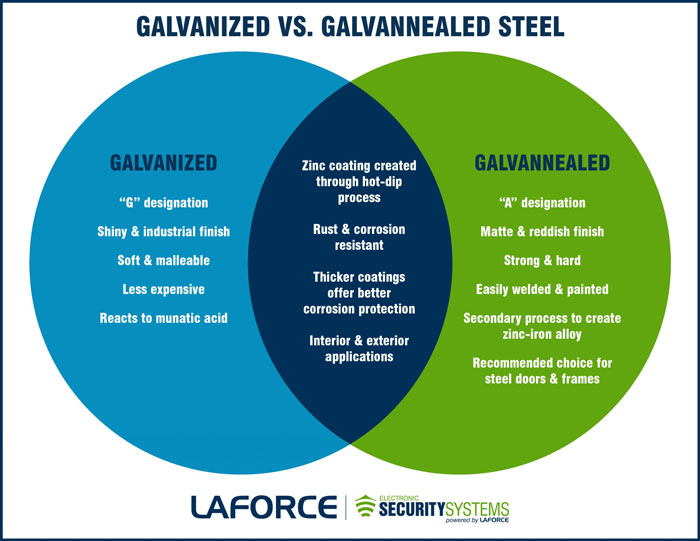Steel doors and frames are popular products that LaForce provides. Galvanized and galvannealed steel are two of the most common forms of carbon steel used in manufacturing these doors and frames. Although they may sound similar, it is important to know the difference between the two coating types so you can choose the right one for your building. Manufacturing process differences will ultimately determine the steel’s capabilities; however, we have outlined the basic similarities and differences between galvanized and galvannealed steel to help you make the best choice.
Similarities Between Galvanized and Galvannealed Coatings
Due to its high iron content, steel is prone to corrosion. Both galvannealed and galvanized coatings are types of zinc coatings designed to prevent the rust and corrosion of the steel. Both are manufactured per ASTM A 653/A 653M. They start the same way by going through the hot-dip process; the steel is dipped into a hot zinc bath, bonding the zinc to the surface of the metal. The process that occurs after the initial dip determines the type of coating and the corresponding properties. It is important to note that zinc-coatings cannot be applied after fabrication due to the thermal distortion of the product.
Whether the coating is galvanized or galvannealed, the coating weight represents the amount of zinc on the steel’s surface. Heavy coating weights provide the most corrosion protection because they contain higher amounts of zinc. Zinc coatings are recommended for exterior applications or interior applications where rust/corrosion might be an issue. It is difficult to compare the corrosion performance of galvannealed and galvanized coatings because galvannealed metal is usually painted, and paint systems have a significant influence on corrosion performance. Whether you choose galvanized or galvannealed metal will depend on the location, application, and desired appearance.
Galvanized Metal
Once carbon steel goes through the hot-dip process, it is considered galvanized metal. The mostly pure zinc coating causes the galvanized coating to have a bright, shiny spangled (marbled) pattern of light and dark gray spots. The pattern of the coating can be controlled by the choice of zinc alloy, hot-dip temperature, and cooling rate, but no two pieces look the same. The unique, shiny surface gives galvanized metal a great industrial appearance. This type of coating is designated with a “G”.
Not only does galvanized steel look different than galvannealed steel, but it also performs differently. Galvanized metal is softer and is easily scratched. Its softness makes it more malleable; it can be formed and shaped without worrying as much about destroying the zinc coating. The thicker the galvanized coating, the better performance against corrosion and the longer the product life. However, a thicker coating also means it is harder to work with. Galvanized steel is also cheaper than galvannealed steel, but it does not react as well to painting or welding. It will also react with muriatic acid if it is not primed or painted. For these reasons, galvanized coatings are not usually recommended for doors and frames unless otherwise specified.
Galvannealed Metal
After going through the hot-dip process, the carbon steel goes through a secondary process to create a galvannealed coating. The zinc-coated steel is heated to a higher temperature, pulling the iron from the steel and causing it to mix with the zinc coating and create a zinc-iron alloy coating. The added iron is what makes the galvannealed metal have different properties than galvanized metal. It also contributes to a different appearance; galvannealed metal has a more consistent, matte finish made of 90% zinc and 10% iron. However, the presence of iron in the coating can cause it to have a red tint, but it does not mean that the steel is rusting. Galvannealed coatings are designated with an “A”.
Galvannealed steel is harder and stronger than galvanized steel – it is not easily scratched. This type of coating is also more easily painted without the need for a primer, although a pretreatment or primer will enhance the performance. Galvannealed coatings are usually painted because it increases their durability and hides the red tint that people associate with rust. Galvannealed metal can also be welded more easily; its high electrical resistance, melting point, and hardness allow for easy welding at lower currents. For these reasons, galvannealed steel is the most recommended for architectural applications, including steel door and frame construction.
Choosing the Correct Zinc-Coated Steel
Zinc-coated steel doors and frames are a great choice when you are worried about rust and corrosion inside or outside your building. To help you decide which one to choose, you should consider the location, appearance, and application of the steel. High-traffic locations are best suited for durable galvannealed metal. Painted or matte appearances are best achieved with galvannealed coatings and unique, industrial looks are best achieved with galvanized coatings. When it comes to shaping the metal, you will need to consider the coating thickness of both metals, but in general galvanized metal is more malleable. If the application of the metal requires welding, galvannealed is recommended. The risk of corrosion will also determine the coating thickness. Although galvanized coatings are sometimes specified, galvannealed coatings are the recommended choice for steel doors and frames.
There are three types of zinc-coated steel typically used for manufacturing doors and frames.
- A40 is a galvannealed coating of 0.4 ounces per square foot and provides minimal protection.
- A60 is a galvannealed coating of 0.6 ounces per square foot and is 50% more protective than A40. The A60 coating is the most common choice for all exterior doors and interior doors exposed to excessive moisture; it is an average thickness that provides good protection but is still easy to work with while maintaining a good appearance.
- G90 is a very heavy galvanized coating that tends to look rough even after it is painted. The added protection of G90 coatings makes them a great choice for extremely corrosive environments (pool areas, salty environments, etc.).
The experts at LaForce can help you decide which steel coating is best for your commercial facility. We can also provide doors and frames for new and existing buildings in hollow metal, wood, stainless steel, lead lined, fire-rated, bullet resistant, and more. Our partnerships with numerous manufacturers also mean we can supply doors, regardless of the quantity, style, and material, for your job. We also have in-house manufacturing facilities for custom doors and frames, allowing us to provide expedited options and control lead times to help your project stay on schedule. Contact us today to get started!




Follow Us